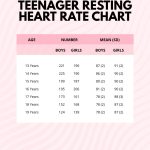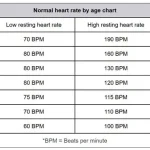As a teenage girl, you’re no doubt familiar with the feeling of your heart racing as you get ready for a big test or a night out with friends. But did you know that there’s more to your heartbeat than just the occasional flutter? Your resting heart rate, also known as RHR, is a vital indicator of your overall health and fitness.
The Importance of Resting Heart Rate
So, what’s the average resting heart rate for a teenage girl like you? Is it something to be concerned about if yours is higher or lower than average? In this post, we’ll delve into the world of RHR and explore the answers to these questions and more.
What is Resting Heart Rate?
In simple terms, your resting heart rate is the number of times your heart beats per minute when you’re sitting or lying down quietly. It’s a great indicator of your overall cardiovascular fitness and can give you valuable insights into how well your body handles physical stress.

As we established earlier, your resting heart rate is a vital indicator of your overall health and fitness as a teenage girl. But what’s the average RHR for someone like you? According to various studies and expert opinions, the average resting heart rate for a healthy teenage girl ranges from 70-80 beats per minute (bpm). However, it’s essential to note that this range can vary depending on several factors, including age, fitness level, and genetics.
Factors Affecting Resting Heart Rate
So, what influences your resting heart rate? There are several factors to consider:
Your physical activity level: Regular exercise can lower your RHR by improving cardiovascular fitness. If you’re inactive or new to exercise, your RHR might be higher.
Stress and anxiety levels: High stress and anxiety can cause a faster heart rate, whereas relaxation techniques like meditation or deep breathing can help slow it down.
Circadian rhythms: Your natural sleep-wake cycle can affect your RHR. For example, if you’re more active during the day, your RHR might be lower at night.
Medical conditions and medications: Certain health issues or prescription medications can influence your RHR. If you have concerns about your heart rate, consult with a healthcare professional.
What’s a Concerning Resting Heart Rate?
If your resting heart rate is significantly higher than the average for a teenage girl (above 90-100 bpm), it may indicate that you’re experiencing increased stress or anxiety. Conversely, if your RHR is lower than expected (below 60 bpm), it could be a sign of poor cardiovascular fitness or an underlying medical condition.
It’s essential to remember that individual variations are normal, and your RHR might not necessarily be indicative of any serious health issues. However, monitoring your heart rate and being aware of any changes can help you make informed decisions about your physical activity and overall well-being.
Conclusion
In this post, we’ve explored the average resting heart rate for a teenage girl like you, as well as some key factors that influence it. Remember to keep an eye on your RHR and make adjustments to your lifestyle accordingly. If you have concerns about your heart rate or overall health, consider consulting with a healthcare professional or checking out resources like the American Heart Association (https://www.heart.org). Stay tuned for our next post, where we’ll delve into some practical tips on how to improve your cardiovascular fitness and RHR.
Get Expert Guidance on Teenage Girl’s Heart Rate
Want to know more about the average resting heart rate for a teenage girl? Our medical experts are here to help.
Consult with a Medical ExpertIn our previous installment, we explored the world of resting heart rate (RHR) and what it means for teenage girls like you. Now, let’s get to the good stuff – what’s the average RHR for a teenage girl?
Average Resting Heart Rate for Teenage Girls
According to various studies and health organizations, the average resting heart rate for a healthy teenage girl is around 70-80 beats per minute (bpm). This range can vary depending on factors such as age, fitness level, and overall health.
What’s Considered High or Low?
So, what happens if your RHR is higher or lower than average? Generally speaking, an RHR above 90 bpm may indicate increased stress levels, a less fit cardiovascular system, or even underlying medical conditions that need to be addressed. On the other hand, an RHR below 60 bpm could suggest excellent cardiovascular fitness or even an overactive parasympathetic nervous system.
Takeaways
In summary:
- Your resting heart rate is a vital indicator of your overall health and fitness.
- The average RHR for a healthy teenage girl is around 70-80 bpm, but individual ranges can vary.
- A higher-than-average RHR may indicate increased stress or less fit cardiovascular system, while a lower-than-average RHR could suggest excellent fitness or an overactive parasympathetic nervous system.
Final Insights
Sixty to eighty beats per minute – it’s a number that can say a lot about your overall well-being. By taking the time to track and understand your RHR, you’ll be better equipped to make informed decisions about your physical health, stress management, and overall fitness journey.
Conclusion
As you navigate the ups and downs of teenage life, remember that your resting heart rate is a vital indicator of your inner workings. By keeping an eye on this number and making conscious choices to prioritize your well-being, you’ll be better equipped to thrive in the face of challenges and come out stronger on the other side.
Quantum mechanical model 5.3 atomic emission spectra: master the science behind light!: Want to know how atoms emit light? Dive into our detailed guide on quantum mechanics and atomic emission spectra, complete with quiz answers and explanations.
The average resting heart rate for teenage girls: stay healthy and fit!: Are you curious about the normal resting heart rate for a teenage girl? Discover how to monitor your heart health with our easy-to-understand guide, covering averages and tips for maintaining a healthy lifestyle.



